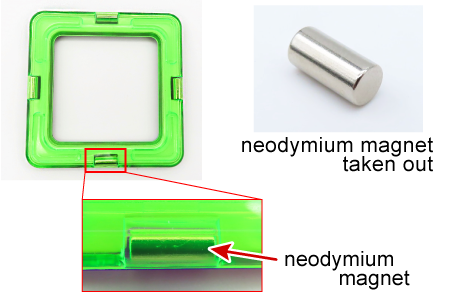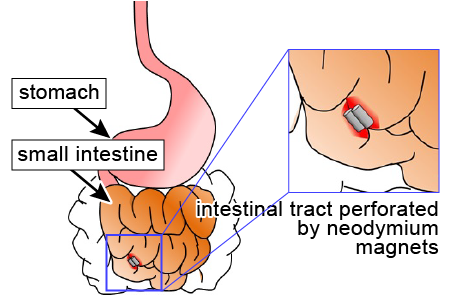Beware of broken magnetic blocks! Accidentally swallowed magnets perforate child's stomach and intestine
In November 2020, NCAC's Doctor Mailbox1 received a report that a child accidentally swallowed a few magnets from a broken magnetic block and the magnets attracted each other across gastrointestinal walls, as a result of which the child needed to undergo surgery. In October 2021, the Doctor Mailbox received a similar report that a toddler accidentally swallowed two magnets from a broken magnetic block and underwent surgery.
Both of the accidents were caused by powerful neodymium magnets came out of broken magnetic blocks. Magnetic blocks are a set of toy parts in the shape of triangle, quadrangular, etc. with built-in neodymium magnets, which can be pieced together into larger surfaces and three-dimensional objects.
On April 19, 2018, NCAC issued an alert about accidental swallowing of small neodymium magnetic balls.2 Although magnetic blocks are different from magnetic balls in the structure and size, neodymium magnets came out of broken magnetic blocks caused similar accidents. Therefore, NCAC decided to issue a consumer alert to prevent similar injuries in the future.
- 1 NCAC has a webpage called "Doctor Mailbox" to catch information directly from doctors about accidental injuries caused by products or services, which will be used to help prevent similar incidents.
- 2 "Accidental ingestion of high powered magnetic balls - infant's digestive tract got holes, and the magnetic balls were removed by laparotomy" released by NCAC on April 19, 2018 (Japanese version)
"Accidental ingestion of high powered magnetic balls - infant's digestive tract got holes, and the magnetic balls were removed by laparotomy" released by NCAC on April 19, 2018 (English version)
What are magnetic blocks?
- Several neodymium magnets are sandwiched between two plastic frames.
- Neodymium magnets therein are in the shape of cylinder and can turn around in a circumferential direction. When a part is moved close to another part, neodymium magnets therein turn around because north and south poles attract each other, as a result of which the two parts stick together.
- Several parts in different shapes can be pieced together into larger surfaces and three-dimensional objects. Magnetic blocks are a popular intellectual training toy for kids. A number of toy manufacturers sell magnetic blocks in similar shapes and sizes.
- Safety of toys with built-in magnets like magnetic blocks is specified by the ST standard (Japan Toy Association). In addition, mechanical strength of toys is specified by EN and ASTM standards. It is considered that an adequate level of toy safety is ensured if a toy bears one of these logos.
Photo: Appearance of a magnetic block and neodymium magnets therein

Accident reports received by the Doctor Mailbox
In both cases, welded frames were broken and separated, as a result of which a few neodymium magnets came out of the product. Then, a child accidentally swallowed the magnets.
- [Case 1]
- A child accidentally swallowed three magnets, as a result of which the magnets perforated stomach and intestinal walls.
- [Case 2]
- A toddler accidentally swallowed two magnets, as a result of which the magnets perforated the intestinal tract.
Illustration: Neodymium magnets perforate intestinal tract

Appearance of products concerned
- Some of the products used at home were badly damaged. If such magnetic blocks are further used, neodymium magnets may come out of them.
Test results
Magnetic flux index of neodymium magnets taken out from magnetic blocks
- Built-in neodymium magnets have strong magnetic force. If two or more magnets from broken magnetic blocks were accidentally swallowed, they may perforate the gastrointestinal tract.
Labeling and representation
- Three out of seven brands indicated possible injuries in case of swallowing neodymium magnets from broken magnetic blocks.
- Only one brand indicated precautions to check magnetic blocks regularly and what to do when magnetic blocks are broken.
Advice for consumers
- It has been reported that accidentally swallowed neodymium magnets from broken magnetic blocks caused gastrointestinal perforation. Make sure magnetic blocks are not damaged before children play with them.
- If a child may have swallowed neodymium magnets, take the child to hospital immediately.
- Check recommended ages of each toy. Children younger than recommended ages should be kept away from the toy to prevent accidental swallowing.
Request to businesses
- Be sure to indicate that magnetic blocks should be checked if there's any damage before use. Keep consumers informed with possible injuries in case of swallowing built-in neodymium magnets.
Request for cooperation to online shopping mall runners
- Remind consumers and sellers that neodymium magnets may come out of broken magnetic blocks and may be accidentally swallowed.
Request to the government
- Further inform consumers with this issue to prevent accidental swallowing of neodymium magnets came out of broken magnetic blocks.
- Encourage manufacturers and sellers to raise consumer awareness of this issue to prevent accidental swallowing of neodymium magnets came out of broken magnetic blocks.
